Media Vehicle, 2009
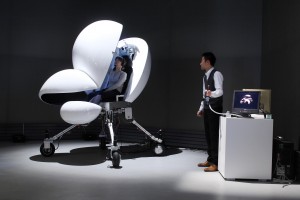
Hiroo Iwata
http://intron.kz.tsukuba.ac.jp/
The “Media Vehicle” is on the go in real and virtual space simultaneously. On board, the driver experiences the environment as a combination of live video images and real movements. A wide-angle camera set up outside the “cockpit” sends live images into its interior. The vehicle’s four legs enable the driver to steer it in all directions.
“The Media Vehicle” opens up extraordinary, multi-layered experiences to its drivers—for instance, in the form of the “Cross-active System” in which one person sits in the cockpit and a second person outside the vehicle operates the camera equipped with a position sensor. The image and motion data from the camera are transmitted inside the vehicle, whereby the person inside gets a feeling like that of a marionette being steered by someone else.
The “Media Vehicle” is ready to hit the streets; thanks to its wheels, it can be driven like a car. If the camera is mounted on the underside of the chassis, the person inside can experience what it’s like to be an insect on the asphalt.
Hiroo Iwata was inspired to create this work by “The Ghost in the Shell,” a Japanese comic whose futuristic plot calls into question, among other things, the sacrosanctity of ones individuality and personality. It’s the account of the “Puppetmaster” who can hack into people’s brains and thus turn them into totally submissive, remote-controlled pods. Another narrative element is the “Fuchikoma”, a car that is simultaneously a terminal for accessing cyberspace. The “Media Vehicle” symbolizes futuristic modes of transportation like this one.
Knock! Music Program, 2007
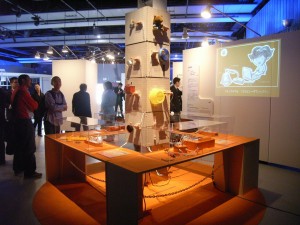
Novmichi Tosa
http://www.maywadenki.com
“Knock! Music Program” is an interactive and playful program for phased learning about technological evolution and digital technology. The stage of development at each step corresponds to a historical advance in technology.
Step 1: Knock with Ton Ton Kun!
Attach the “knocker” to anything that makes an interesting noise. Make a knock with the large “Ton Ton Kun” button.
Step 2: Knock with the “Fun Button”!
Make the button with a simple design. Knock by connecting it to “MIDI-TAP”!
Step 3: Knock with Ele-Beat!
Use the magnetic type sequencer “Ele-Beat,” and practice how to type in to knock!
Step 4: Knock with the Computer!
Now that you’ve gotten the experience of tapping on a computer, just feel the rhythm of that knock and dance!
Nicodama, 2009
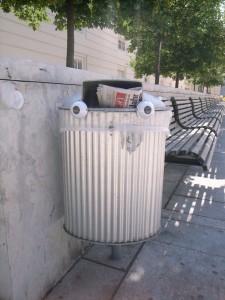
Ryota Kuwakubo
http://www.vector-scan.com/
“My mother has packed my school lunch box once in such a way that the contents were in the form of a face… but then I could never get myself to eat them.” (Ryota Kuwakubo)
Human beings acquire the ability to recognize faces and differentiate among them during the first few months of life. The face is the most familiar pattern in the world to us, which is why we also tend to discover faces almost everywhere we look: in technical equipment, on the Moon, in the clouds.
But we react especially emotionally at the sight of big eyes—in complete accordance with the “infant schema,” this facial feature exerts a powerful stimulus to engage in care-giving behavior.
“Nicodama” combines findings from the field of behavioral biology (ethology) with technology and Japanese philosophy. Wherever the big eyes are set up, faces emerge. The “Nicodamas” communicate with each other via infrared interface and blink at random intervals that can’t be influenced externally.
In Japanese culture, one proceeds under the assumption that everything—whether it’s animate or inanimate—has a soul. The upshot of this conception is care and increased respect in dealing with the environment—regardless of whether this is a matter of human beings or physical objects.
“Nicodama” enables us to get a completely new, emotional view of our environment and the objects that surround us. It thus expands the objectifying, quantitatively measuring, and strategic worldview of our day and age.
loopScape, 2003
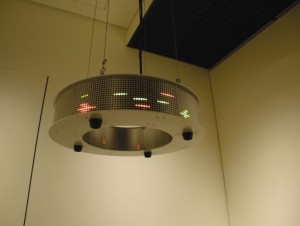
Ryota Kuwakubo
http://www.vector-scan.com/
“loopScape” is an innovative video game for two players that blurs the conventional distinction between good and evil, between “my side” and “the opposition.”
The action doesn’t take place on a flat display but rather on a 360° band arrayed around the edge of a ceiling-suspended metal “doughnut” that’s circumnavigated during play. The object is to shoot down the opponent. But be careful! If a fired missile misses its target, it continues on its trajectory and threatens to strike from behind the game figure that launched it.
Hideyuki Ando – Touch the small world, 2009
http://www-hiel.ist.osaka-u.ac.jp/~hide/
The sense of touch is one of our most primal and direct modes of contact with the world. Even minute surfaces can give rise to elaborate worlds of imagery in our mind, a process in which tactile stimuli encounter emotional values, and the tangible meets up with what is difficult to grasp.
With our fingertips, we can feel even the finest irregularities on a surface—even those smaller than a fifth of a millimeter. The tiny grooves in our skin play a part in this; they amplify the vibrations produced when we rub our fingers over a surface, whereby the frequency of the vibration corresponds to how quickly we stroke the surface. “Touch the small world” is based on this phenomenon.
This new interface uses vibrations applied to the user’s fingertips to produce the illusion of a surface texture. This makes it possible, for example, to “touch-read” an image in a picture frame. Sensors register the position of the fingers; a four-prong piezo transformer delivers a vibration with pinpoint accuracy.
Hideyuki Ando was awarded an Honorary Mention in the 2009 Prix Ars Electronica’s Interactive Art category (together with Yasushi Noguchi) for “Watch me.”
"Fairy Finder" series — It Could be Magic…
Kazuhiko Hachiya
www.petworks.co.jp
“Any sufficiently advanced technology is indistinguishable from magic.” —Arthur C. Clarke, author of “2001. A Space Odyssey”
“If modern-day technology still doesn’t seem all that magical, then that’s mostly because it hasn’t been sufficiently perfected yet. Something’s missing—beauty, perhaps, or romance. In any case, something that connects people all over the world, or astounds all of them in equal measure. This task contains the deeper meaning of a connection linking science and art.” —Kazuhiko Hachiya
Table of the Colobockle, 2004
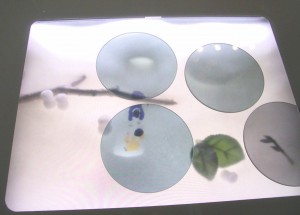
“This work originated several years back at the time when I became a father. The desire that led to this work emerged when I was playing peek-a-boo* with my child, who laughed and laughed without seeming to get the least bit bored.
Other sources of inspiration were Satoru Sato’s stories about ‘Colobockles’, tiny creatures who live quietly and secretly among us. These accounts are based on legends from Northern Japan. Even though they’re just fairy tales, I couldn’t help but wish that they were real.”—Kazuhiko Hachiya
*Peek-a-boo is a game for little children in which adults hide their face behind their hands and then suddenly pull their hands aside accompanied by a loud “peek-a-boo!” For babies, this game is a first little window providing a glimpse into a big new world full of exciting secrets.
Mermaid in the Window, 2007
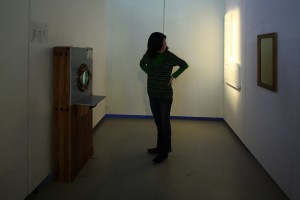
“One time, I traveled by ship to Hokkaido. Late at night, I went out for a stroll on deck. As I looked out at the dark, rain-pelted, seemingly endless expanse of ocean, I was overcome by a kind of horror. I had the feeling that the sea at night was the closest thing on Earth to the Great Beyond. But what was really strange about it was that this feeling was nevertheless somehow nostalgic.
A bar with an old-fashioned window that looks like it came from a shipwreck is the setting of this work. If you stand in front of the bar and look over your shoulder behind you in the mirror, you discover a woman—perhaps Lorelei, the mythical siren whose singing on a rock in the Rhine lures sailors to their doom on the reefs.” —Kazuhiko Hachiya
Surrounding of Firefly, 2009
Masahiko Inami
Most of the phenomena of this world—lights as well as sounds—occur at frequencies that are often too fast for our senses to register.
These stop-motion glasses with their liquid crystal display open up a completely new world to us—one that functions a bit differently than the one revealed to us by the naked eye.
Suddenly, we can perceive other frequencies and see other characteristics of light—for instance, the way it blinks like a firefly does.
Plus, stop-motion glasses used in everyday life offer many other advantages—for example, transmitting confidential, encoded messages at a frequency that can only be seen with a customized pair of glasses and not with the naked eye. Stop-motion glasses offer a new visual experience; they will revolutionize visual perception as dramatically as the telescope did in enabling human beings to see very distant objects.
Morpho Tower Series, 2006
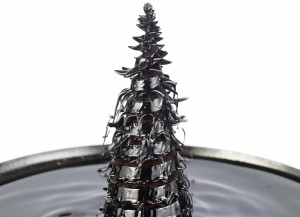
Sachiko Kodama
http://www.kodama.hc.uec.ac.jp/
The Ars Electronica Center exhibited “Protrude, Flow,” a work by Sachiko Kodama and Minako Takeno, from 2003 to 2006. Further development of its basic idea led to the “Morpho Tower” series.
Both works employ ferrofluid. This consists of a liquid medium in which a few nanometer-size magnetic particles are suspended, so that the fluid reacts to a magnetic field.
The spiral enwraps an electromagnet with an enlarged iron core. The strength of the electromagnet determines the movement of the ferrofluid. The fluid can move along the spiral form all the way to its pinnacle—seemingly defying gravity.
The spiral is considered a widespread element in art, a shape present in Sandro Botticelli’s “Primavera,” the landscapes of Vincent Van Gogh, Robert Smithson’s Land Art and the sculptures of Richard Serra. Sachiko Kodama takes up this historical tradition and, in the form of “Morpho Tower”, translates it into contemporary media art.


